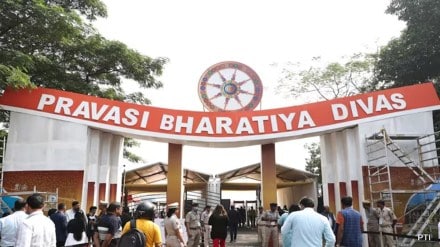By Hindol Sengupta,
In 1894, Swami Vivekananda wrote in a letter about his work in America, “I find I have mission in this country too… One blow struck outside India is equal to 100,000 within.” Even though Vivekananda was talking about his own context, that of being a citizen of colonized India, he could have well been talking about the impact of the Indian diaspora, perhaps the most prominent, and successful diaspora communities in the world.
Today, the Indian diaspora stands at 35.4 million, including 19.5 million PIOs and 15.8 million NRIs. The USA has the highest number of Persons of Indian Origin (PIOs) — over 3 million. The United Arab Emirates (UAE) has the highest number of Non-Resident Indians (NRIs) – over 3.5 million. They not only send back the largest quantum of remittances received by any country from its diaspora, but also are usually considered a model minority, more educated, wealthy, and assimilated than any other in any country where they exist in considerable numbers.
One-third of tech employees in Silicon Valley, and more than 60 per cent of CXOs in the top 300 global companies, are of Indian origin. From banana cultivation in New South Wales in Australia to running Microsoft and Google, the Indian imprint stretches across the world. The Indian diaspora, which sent back more than $120 billion last year, has been a positive talking point in the country’s outreach and diplomacy for several decades now. In a sense, what Indian outbound students now spend when they leave home to study in colleges and universities overseas, comes back in ample measure by the growing record levels of remittances that the growing Indian diaspora sends back home. From Iceland to New Zealand, the Indian diaspora has managed to build bridges and connections where, sometimes, none previously existed.
To celebrate, and highlight, what an important material and narrative resource the diaspora is, we have had the Pravasi Bharatiya Diwas each year since 2003 on the 9th of January, the very day on which Mohandas Gandhi landed in India from South Africa to transform the Indian freedom movement and in the process become Mahatma. In 2015, the Diwas moved to a biennial format involving not only prominent members of the diaspora but also experts helping with the understanding of the power and influence of the diaspora. The event also includes the handing of the Pravasi Bharatiya Samman Awards to achievers from the community – till date 296 of these have been given out, and they are the highest honours members of the diaspora or diaspora institutions can receive (apart from the high civilian Padma awards given to individuals). While every prime minster has sought to engage the diaspora, it is undeniable that Prime Minister Narendra Modi has taken personal interest and nurtured a very and intimate relationship with the diaspora in whichever country he has visited. In fact, the vibrant and colourful personal relationship of the prime minister with the Indian diaspora is one of the most visible parts of the Modi framework of foreign policy.
In the recent past, the Diwas has been organised in collaboration with various state governments, and this year, the 18th convention is being organised in Bhubaneswar, Odisha from 8th-10th January with the theme Diaspora’s Contribution to a Viksit Bharat. The choice of Odisha is apt as one of the great sites of trade and commerce and through which ancient India interacted with the rest of the world. As India marks a decade of its Act East Policy, Odisha is a vital hub, with its grand shoreline, foundational ports, and its historic maritime ties across southeast Asia, to unlock opportunities and partnerships across the ASEAN region and the Indo-Pacific. Monks and merchants once travelled from Odisha taking Indian ideas across the Indian Ocean, and elsewhere, and these ties are now being rekindled. A Ramayana exhibition is planned at the PBD – an epic which is revered and celebrated across southeast Asia. The hosting of the Diwas in Odisha also furthers the government’s Purvodaya plan focussed on greater development in five key states – Odisha, West Bengal, Bihar, Jharkhand and Andhra Pradesh.
This is a perfect moment to reflect upon the crossroads India stands at with its successful diaspora. The global controversy and backlash over immigration – legal and illegal – has consequences for all countries like India who have a large and growing diaspora. What India does not want is for any dent to appear in the story of the Indian diaspora as the most enterprising and well-adjusted and assimilated community among diasporas. It would not want any lazy or untoward conflation of the story of the Indian immigrants with other immigrants from other parts of the world. There is an opportunity and a challenge in this.
This is the moment to hold up and showcase the successes of the Indian diaspora – the greater the spotlight on the success stories, the more discernible and distinguished the Indian diaspora story will be. The more it gets coupled with a broader global narrative, the more the confusion and the challenge. New platforms and methods must be found to keep the Indian diaspora story distinct. What is most critical in this is that the Indian diaspora itself invests more critically and in a more lasting, long-term manner in telling its own story. For most of its history, the Indian diaspora has been content to succeed as individuals, even families, but the comprehensive joining of dots, and telling the overall tale remains. This is a pledge worth making during the upcoming Pravasi Bharatiya Diwas. As Swami Vivekananda would have understood, this is an urgent mission now.
The author is a historian and author of 12 books. He is professor of international relations at OP Jindal Global University.
Disclaimer: Views expressed are personal and do not reflect the official position or policy of Financial Express Online. Reproducing this content without permission is prohibited.
